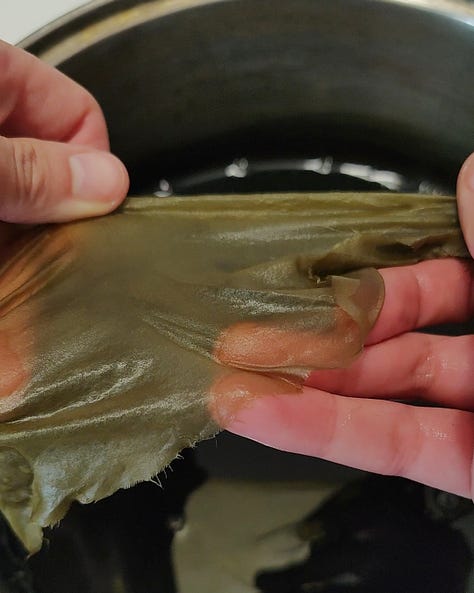Kaliko Journal is a free newsletter about natural dyeing, textiles, art practice, and life by Ania Grzeszek. This publication is divided into two sections: ”Plant Dyeing” and “Studio Practice”. You can manage your subscription by clicking “Unsubscribe” at the bottom of the email and opting IN and OUT of the sections that interest you. This is also where you can pledge your financial support for this publication, which would help me continue to sustain it.
Feel free to share parts of this letter wherever and with whomever you’d like, remembering to tag me. If you want to support my work, subscribe to this publication and/or purchase my handmade products. Take care of yourself wherever you are.
One of my very favorite memories is from my daily walk two years ago. It was May. There’s this small natural reserve 10 minutes walk from our flat—and by small I mean really small, maybe 1 hectare (2,5 acres) total—I go there with my dog every day. There’s a pond where dogs are allowed to swim, there are viburnums, rhododendrons, willows, jasmine and wild cherries. Squirrels and cranes, ducks, even wild foxes live there.
Previous days were already super hot, and on that day, in the early morning hours, it rained for a while. The air didn’t cool down, though, so for a short time, just as I was walking my dog, it happened to be very warm and also very humid. And because it was May, and because it was so warm and humid, when I entered the natural reserve I was hit by the most unimaginable wave of smells. Like a tsunami of the most intense spring fragrances I have ever experienced.
I think about that day a lot, it was just the most magical moment. It’s the only time I experienced it so vividly, usually it’s not warm enough, or not humid enough, or the blooming season is off. But on that special day everything played all at once and I don’t think I will ever forget this smell and feeling.
May is quite cold in Berlin this year, but local plants don’t give up and keep blooming. I love this season, walking around, taking all the flowers in my hands, smelling them obsessively. Touching and stroking them. Learning about what grows around me.
Make sure you make the most of this time of the year. Smell flowers, take in all the colors, and, of course, test dye plants. This is a perfect season to experiment and learn, and maybe slow down a little in the process.
There’s an abundance of fresh nettles around my studio, so this is what landed in my test dye bath last week. I collected ca. 200g of nettles, picking them up with scissors not to get burned. (I still got burned slightly, but for some reason I like it.) I put them into an enamel pot, covered with ca. 3l of tap water and simmered for one hour. Now, the experiment I wanted to try, went like that:
I sieved half of the extracted dye into one pot, and left the other half in the original pot, together with the nettles.
I put 3 mordanted silk samples to each pot. The pot with the sieved dye was simmered for an hour, the pot with the nettles inside wasn’t heated up anymore.
I took out one samples each after: 1 hour; 2 hours; 24 hours.
I added mordanted silk samples into both dye baths on the second day, heat up both and took them out after an hour.


What I love about experimenting is learning new things and gaining experience, what I don’t love is not knowing for sure why things happen. Chemistry background would come handy at this point, but all I can do, unfortunately, is guess.
So my guess is, sieved nettle dye bath oxidised overnight and got darker and greener. The dye bath with plant parts in it didn't oxidised and produced consistent vibrant yellow. Heating up could speed up oxidisation process, having plant matter in the dye could slow it down. But don’t take my word for it, find a trusted chemist and let them confirm or deny.



Here’s all the samples together, from both dye pots.
Left column is mordanted silk, dyed in a sieved nettle dye.
Right column is mordanted silk contact-dyed (dyed with plant matter in the dye pot).
The top 6 samples were all placed in the pots at the same time and taken out after 1h, 2h, 24h. The sieved dye bath kept getting darker and greener, while the dye bath with nettles still inside kept stable vibrant yellow color.
The two bottom samples were placed in the dye pots for just 1 hour the next day. There’s visibly less yellow dye on these samples, with more muted green-grey coming to the forefront.
One thing to mention is that I tested nettles from the same spot around 3-4 weeks ago, and they were nowhere near being as vibrant the ones you see here. In my experience, they reach they peak strength around late May / early June, just like many other dye plants. Cow parsley is another of my June favourites!
I hope I could inspire you to go out this week and experience the main that is currently happening in front of our eyes.
May we all find some time to stop and smell the flowers.





